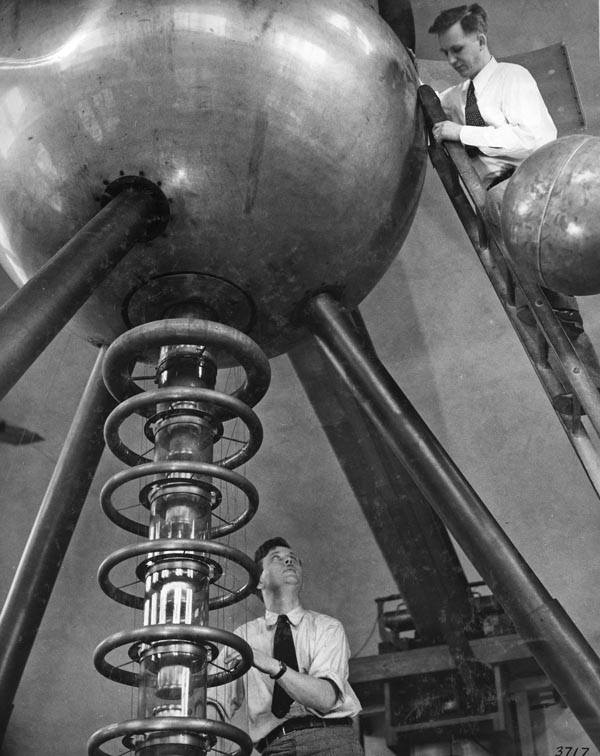Explore the Collections
The Carnegie Institution of Washington (now called Carnegie Science) was founded in 1902 as an organization for scientific discovery. Shortly thereafter, two departments were set up to conduct basic research in the Earth sciences: the Department of Terrestrial Magnetism or “DTM” (1904) and the Geophysical Laboratory (1905).
 |
| DTM physicists Merle Tuve and Odd Dahl making adjustments on the Van de Graaff generator in 1935, Image No. I3717 |
The initial mission of DTM was to map the magnetic field of the entire Earth and to quantify its mysterious variations in space and time. To that end, DTM deployed an arsenal of geomagnetic instruments in the early 1900s for its World Magnetic Survey, including specialized instrumentation for geophysical observations at sea. In the 1920s and ‘30s, research shifted to studies of the ionosphere and to atomic physics. DTM scientists constructed a series of increasingly powerful electrostatic accelerators, culminating in a 3-million volt Van de Graaff generator that was used in 1939 to split the uranium atom. After World War II, new areas of investigation were opened in seismology, biophysics, isotope geochemistry, radio and optical astronomy. Each field required highly specialized instrumentation, which was systematically documented in photograph albums from shortly after the Department’s founding through the 1950s, when the practice was finally abandoned. Today, DTM research spans geophysics, geo- and cosmochemistry, planetary science, astronomy, and astrophysics.
 |
| Geophysical Laboratory petrologist J. F. Schairer with quenching furnaces in 1968, Image No. E029. |
From its inception, the Geophysical Laboratory has explored the borderland between physics, chemistry, and geology. In its early decades, research centered on understanding the formation and evolution of rocks and minerals. Laboratory scientists constructed special apparatus to replicate the pressure and temperature conditions found in the Earth’s crust and to analyze gases and fluids collected from volcanoes. In the 1920s, crystal structure determinations using the new technique of x-ray diffraction were begun, and the following decade, studies of radioactive isotopes. In the post-War era, pioneering programs in organic geochemistry and geochronology (the latter, in collaboration with DTM) were established. Mineral physics followed in the 1970s. Current research at the Geophysical Laboratory is highly interdisciplinary, ranging from studies of matter in extreme environments to the origins and limits of life on Earth and in the cosmos. Photographs of instrumentation in the Geophysical Laboratory’s archives are comparatively few, but do include some complete laboratory interiors as well as early high-pressure and high-temperature apparatus.
The pages featured here highlight selected images from the instrument photograph collections. While the subjects explored do not represent every type of instrument found in the collection, they identify some of the collection's prominent themes.
